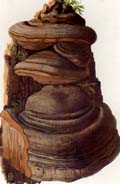 Key to Gilled Mushrooms Key
Key to Gilled Mushrooms KeyThis is a key to gilled mushrooms, that is, mushrooms having a definite cap with a fertile surface consisting of gills. The fruiting body usually also has a stem, although that may be lateral or absent (usually, then, the mushroom is growing from wood). You can use this key to identify mushrooms that you find.
 Polyporaceae Family
Polyporaceae FamilyFertile surface usually a layer of vertical tubes, of which the mouths are visible as pores on the underside of the cap or shelf.
Fruiting bodies usually tougher or harder than the "normal" gilled mushrooms, being leathery, corky, or woody. But they can be quite tender while actively growing
Once grown, they do not decay easily, remaining on the substrate for months or years
They often grow on wood, although a few are terrestrial (even those are usually growing on buried wood)
Fruiting body is usually a flat shelf, or hoof-shaped, protruding directly from the substrate, although sometimes it may have a short stalk.
Some forms never grow away from the substrate at all, so that all that is visible of the fruiting body are the pores.
Sometimes the pores are so minute that the fertile surface seems solid, until you look closely
 Lignicopolypore Subfamily
Lignicopolypore SubfamilyGrowing on wood
Sessiloporus TribeNot fitting the other choices, not stipitate
In making choices below based on texture and size, place the emphasis on texture: if left alone, some of the smaller ones can eventually get quite big; and even the huge ones have to start out small at first
 Big Sessilopolypore Subtribe
Big Sessilopolypore SubtribeFruiting body large (often over 6" across), perennial and hard; often hoof-shaped or convex, but may also be shelving
If the choice is between this and Medium Sessilopolypore, place fungi here if they have any of the following characters: perennial, hoof-shaped, hard
Heterobasidion Genus Brefeld
Diagnosis
Microscropic Characters
Narrow down your identification:
Heterobasidion annosumCap up to 6" across
Stalk with a bulbous base






 Key to Gilled Mushrooms Key
Key to Gilled Mushrooms Key Polyporaceae Family
Polyporaceae Family




